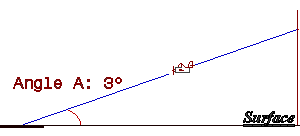
Instrument Pilot Courses of Instruction
531
Steve Sconfienza, Ph.D.
Airline Transport Pilot
Flight Instructor: Airplane Single and Multiengine; Instrument Airplane
cell: 518.366.3957
e-mail: docsteve@localnet.com
What is 531 and why is it so important? Well, it is actually 5 point 31, and it just so happens that if you multiply your ground speed (knots) by 5.31 the result is the vertical speed in feet per minute necessary to hold a standard three per cent glide slope of an ILS! For example, at 100 knots, a 3° glide slope requres 531 feet/minute descent rate.
Standard precision instrument approach procedures generally incorporate a three degree descent profile (e.g., an ILS glide slope), although some differ; also, VASI and other approach references are typcially at or near three degrees.
It just so happens that 5.31 is the reduction of three terms based on the trigonometry of an ILS.

To solve the triangle, first convert to common units. To convert knots (ground speed) to fpm (vertical speed) do the following:
Then to solve the triangle (now that all terms are in the same units, fpm) do the following:
Which rearranges to
Where tan 3° = 0.052408 (from any slide rule, trig table, or — even — a computer!).
But this can be reduced to one step, given the three constant terms will always be there: tan 3°, knots to fpm conversion factor, and –per hour to –per minute conversion factor. So this reduces to the following:
At this point, move the ground speed to the left of the equal sign by multiplying both sides of the equal sign by the quantity ([gs] knots * 101.269), which gives...
Which rounds to [gs] knots * 5.31 = [vs] fpm
I am So Cool!
While most glideslopes in the United States are three degrees; however, this is not a standard that is cast in stone. Yes, there are those odd ones out there, typically, in the range down to 2.5 degrees or up to 3.1 degrees, so it's best to be prepared before your heading down the ILS.
The United States Standard for Terminal Instrument Procedures TERPS, Third Edition [8260.3B]) provides information concerning the maximum authorized glide slope angles by aricraft categories. (The arcraft categories are defined in 14 CFR 97 and are based on the aricraft's computed indicated approach speed [1.3 Vso] at the maximum certificated landing weight.) Glide slope angles above three degrees require the approval of the the FAA's Flight Standards Service (or relevant military authority).
| Aircraft Category | Maximum Glidepath Angle | ||
|---|---|---|---|
| A | 1.3 Vso | 80 knots or less | 6.4 |
| 81 to 90 knots | 5.7 | ||
| B | 4.2 | ||
| C | 3.6 | ||
| D | 3.1 | ||
| E | 3.1 | ||
N.B. You can come down the approach course at any speed you want (i.e., VREF as chosen by you): the official "approach category" for the aircraft is based only on 1.3 VSO, the aricraft's computed indicated approach speed at the maximum certificated landing weight.
A table of descent rate conversions besides 5.31 is available for the curious, obsessive, or those that happen to be flying such a glide slope:
As an aide in computing approach descent rates versus groundspeed, this table provides knots-to-fpm conversions for the full range of authorized glide slope angles.
This interactive spreadsheet computes descent rates (in fpm) per groundspeed (in knots) based on the descent profile (including non-standard glide-slope angles).
There are two interactive worksheets in the file:
Setting it at three degrees generates a reference for descent rates by speed for a standard ILS. For flight planning purposes, the second worksheet is configured to print on a single page for in-flight reference (but do a "print preview" and check the settings on your own printer).
You may have noticed that the topology of the ILS is always going to be a right triangle, with the three legs being ground speed, vertical speed, and airspeed, and no, airspeed cannot be identical to ground speed in still air: the vertical component absorbs some amount of the travel (the airspeed), thus in still air the ground speed will be lower than the airspeed. How much? Well, not a whole lot, not worth the effor to compute, but just so that you know, assume a 100 knot groundspeed for the following (e.g., as read from an ILS-DME):
[times 60 minutes per hour divided by 6,076.12 feet per mile . . .]
The website "Flightinfo.com" has various rules of thumb related to ILS approaches.
[ TOP ]
[ FLYING HOME ]
rev. 7 December 2012
Copyright © 2012-2020
Steve Sconfienza, Ph.D.
All Rights Reserved